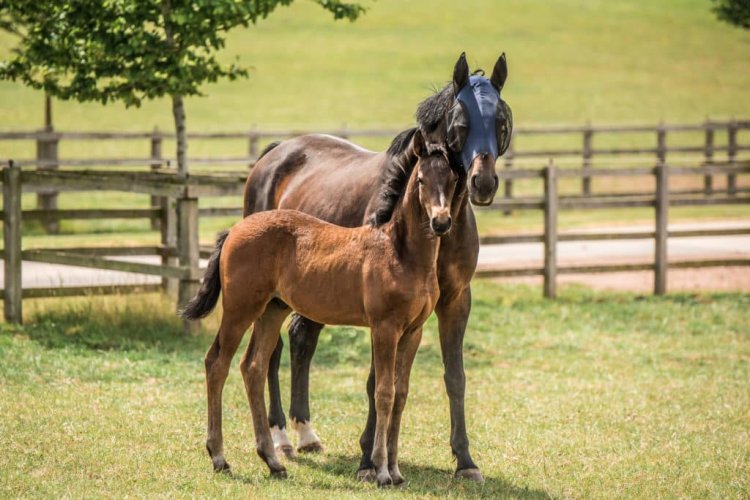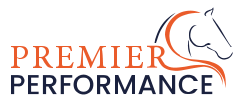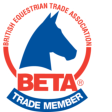in basket
Feeding the mare and foal during weaning

Introduction
Weaning usually occurs at around 6 months of age in most management practices; however, some foals are weaned as early as 3 months of age. In the wild weaning usually takes place when the foal is around one year old, usually when the mare is next giving birth. This takes place gradually; the mare begins to discourage the foal from suckling and consequently she produces less milk and so the foal gradually becomes reliant on other food sources.
In the domesticated setting, weaning takes place when the foal is around 6 months of age and this can be a very stressful time for both the foal and the mare. The separation from each other coupled with possible changes in their environment, diet and management makes this a difficult time for foals. Foals will demonstrate this stress by vocalisation, motor activity (running around), and may also have a reduced appetite. It is also likely that their heart rate and cortisol secretion will be increased. You may recall from previous articles that cortisol is produced during times of stress and this decreases the body’s inflammatory and immune responses. The reduced appetite during weaning can also result in slower daily weight gain during and post-weaning. Foals can often develop gastrointestinal and respiratory tract infections at this time.
It is therefore important to plan your foal’s weaning, unless of course your mare suddenly becomes ill or injured, or at worst dies, then weaning is abrupt. Planning weaning allows you to help minimise the potentially negative effects of this stressful process to help ensure your foal has the best possible outcome. From a development perspective, it is important that your foal becomes independent, and the weaning process begins the training steps towards this without the mare’s influence.
Management
If there are more than one pair of mares and foals, then keeping them in larger groups from around 1 month onwards can be beneficial as this allows for the mares to be gradually removed. For example, at around 5 to 6 months of age one mare can be removed from the group at a time to a space where they cannot be heard or seen by the others. The foal from that mare is likely to be somewhat distressed for a relatively short period of time but will usually return to the group and settle. The process can then be repeated until the last mare is removed. If there is only one mare and foal, then an older companion can replace the mare, or the mare and foal can be separated (with good fencing) into different pastures or in stables.
Studies have shown that an abrupt removal of the mare without the above measures in place is incredibly stressful. Even if two foals stabled together without their mothers, studies have shown their cortisol levels to be extremely high and in fact higher than if they were stabled alone.
Ideal diet for the mare during weaning
In early lactation a mare’s nutrient requirements, in particular energy, are high; however, as lactation progresses and then the foal is weaned the mare’s requirements reduce. Once the foal has weaned the main goal is to reduce the mare’s milk production for her comfort and to avoid problems, such as mastitis. If the mare is in good condition, then she can be managed in the same way as a non-pregnant mare. If the mare is pregnant again when the foal is weaned, then it’s important to monitor her weight and to increase her forage intake and, if required, feed additional feedstuffs that are higher in energy such as alfalfa and sugar beet pulp. Selecting feeds that are high in digestible fibre provides additional energy whilst maintaining gut health.
Ideal diet for the foal during weaning
A mare’s milk is the source of nutrition for a newly born foal, with colostrum (or first milk) providing the essential antibodies needed to protect the foal from infection. Colostrum is also high in fat, which is an important energy source for the foal. In the majority of cases a mare will produce enough milk to sustain her foals; however, when that is not the case there are many good milk substitutes available. In the wild, foals have access to forage from birth. As I have mentioned on many occasions now, forage is the basis for equine nutrition. It not only provides nutrients but is essential for gut health and for the welfare of the animal. Foals will begin to nibble at pasture and forage from a very young age, usually around 2 weeks of age and if the mare is fed then they will begin to eat a little of her feed as well. When to introduce additional feed, commonly known as creep feeding, is very much down to the individual foal and depends on the growth rate of that foal.
The main focus on feeding foals is to ensure that they do not grow too quickly. A horse that grows quickly is at greater risk. As discussed in previous articles, growing horses are at risk of developmental orthopaedic diseases (DOD). It is therefore important to regularly monitor the growing horse’s weight and body condition (see previous article on managing your horse’s weight). The main reason for providing creep feed is to provide additional energy in the diet, which is not required for those foals growing well, but may be necessary for those that are not growing at the expected rate. A foal’s nutrient requirements begin to increase around 6 weeks of age and creep feed may be required at this stage, but this depends on the growth and body condition of the foal. A creep feed may also be used to help balance the diet for vitamin and minerals and as such a forage balancer for young stock where additional calories are not required is beneficial. A balanced diet is important in reducing the risk of the foal developing DOD.
The quality of a mare’s milk does begin to decline at around 3 months and if a foal is not growing as well as expected or has a low body condition then it may be that the mare is not producing enough milk. If this is the case, then creep feed for youngstock may be beneficial at this stage; however, it is also important to reiterate that foals can be given access to forage to increase nutrient intake. If bodyweight is lower than expected before the foal reaches 3 months of age, then a milk-based creep feed is best rather than one designed for older foals. This is because the foals’ digestive tract is still immature and is still well able to digest milk. However, by 4 months of age the mare’s milk is unlikely to provide enough nutrients for the foal, at this stage the foal will receive 30 to 50 percent of their nutrients from milk. However, the foal’s ability to digest forage increases after weaning as does the amount of forage eaten. Growth rate also slows after weaning and as such forage intake alone may be enough to meet the nutritional requirements of the weanling along with a forage balancer to ensure vitamin and mineral requirements are met.
Article written for Premier Performance by Professor Jo-Anne Murray.






